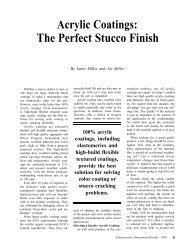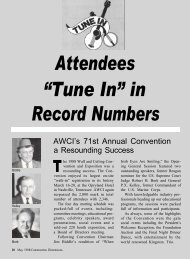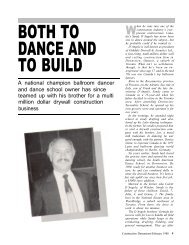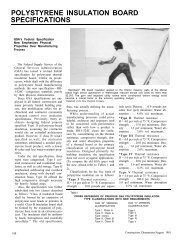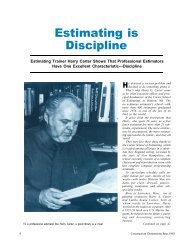Dynamism at Dryvit -- Interview with Frank Morsilli - AWCI
Dynamism at Dryvit -- Interview with Frank Morsilli - AWCI
Dynamism at Dryvit -- Interview with Frank Morsilli - AWCI
You also want an ePaper? Increase the reach of your titles
YUMPU automatically turns print PDFs into web optimized ePapers that Google loves.
<strong>Dynamism</strong><br />
<strong>at</strong> <strong>Dryvit</strong><br />
Providence’s <strong>Frank</strong> <strong>Morsilli</strong> Knew He Had a Winner on<br />
First Look—And Then Proceeded to Prove It<br />
With a f<strong>at</strong>her and three uncles in the<br />
trowel trades, <strong>Frank</strong> <strong>Morsilli</strong> understood<br />
the implic<strong>at</strong>ions of the invention<br />
instinctively: it was a potential<br />
bonanza.<br />
Furthermore, as one <strong>with</strong> an avuncular<br />
dislike for knee-jerk reactions,<br />
<strong>Morsilli</strong> knew th<strong>at</strong> the stucco-like<br />
product which its inventor was twisting—<strong>with</strong>out<br />
a single hairline crack—<br />
could be his to provide North American<br />
construction <strong>with</strong> a bit of future<br />
shock. Th<strong>at</strong>’s why the Providence,<br />
R. I.-born businessman sealed an<br />
agreement <strong>with</strong> the inventor, the l<strong>at</strong>e<br />
Edwin Horbach, <strong>with</strong> a handshake—<br />
then went home and cre<strong>at</strong>ed <strong>Dryvit</strong><br />
System, Inc.<br />
It would be nice to say th<strong>at</strong> construction<br />
greeted <strong>Frank</strong> P. <strong>Morsilli</strong><br />
and his new Outsul<strong>at</strong>ion idea <strong>with</strong> the<br />
excitement th<strong>at</strong> occurs <strong>at</strong> a historical<br />
junction. Fact is, the reaction was<br />
‘show me.”<br />
And show them he did . . . <strong>with</strong><br />
geometric leaps in company growth.<br />
Starting in Cranston, R.I., <strong>with</strong> a onestory<br />
2,000 square feet building, <strong>Morsilli</strong><br />
and his company kept plugging<br />
away <strong>with</strong> an outside-insul<strong>at</strong>ion concept<br />
th<strong>at</strong> exists on 40 percent of all<br />
European buildings and is utilized on<br />
80 percent of all buildings th<strong>at</strong> are<br />
retrofitted.<br />
With the ’73 oil embargo and the<br />
Construction Dimensions/October 1982<br />
consequent fuel shortage crises, the<br />
impact of making buildings energyefficient<br />
came on full force—and <strong>with</strong><br />
it came the <strong>Dryvit</strong> surge. Today, <strong>Dryvit</strong><br />
is still rapidly growing <strong>with</strong> factories<br />
in Warwick, R. I., Tulsa, Okla.,<br />
Columbus, Ga., and a fourth scheduled<br />
for completion and oper<strong>at</strong>ion this<br />
year in Woodlake, Ca. A fifth factory<br />
is already on the drawing boards.<br />
For <strong>Frank</strong> <strong>Morsilli</strong> the last few<br />
years have meant full cycle—and a<br />
new phase of opportunities. Born in<br />
North Providence, son of master plasterer,<br />
Peter, and Clementina Iafr<strong>at</strong>e<br />
<strong>Morsilli</strong>, both of N. Providence,<br />
<strong>Frank</strong> came into the construction industry<br />
via a business administr<strong>at</strong>ion<br />
degree from University of Rhode<br />
Island and a full hitch in the U.S.<br />
Navy as a Surface Warfare Officer.<br />
Discharged in 1957, he opted for a<br />
full-length Naval reserve commitment<br />
while building his priv<strong>at</strong>e business<br />
career. He just recently retired after 23<br />
years in the reserves, <strong>with</strong> the rank of<br />
Captain.<br />
In priv<strong>at</strong>e life he went to work as<br />
a brick salesman and distributor,<br />
gradually buying out his employer, P.<br />
L. Monroe & Son, Inc. A series of acquisitions<br />
and mergers finally produced<br />
the <strong>Dryvit</strong> Company—but not<br />
until <strong>Frank</strong>’s constant search for a<br />
new approach to old problems finally<br />
produced the Horbach breakthrough<br />
. . . the primus mesh and finish over<br />
foam.<br />
Th<strong>at</strong> competitors—observing the<br />
huge wake which <strong>Morsilli</strong>’s <strong>Dryvit</strong><br />
oper<strong>at</strong>ion is making—have shown up,<br />
even <strong>with</strong> possible p<strong>at</strong>ent infringements,<br />
comes as no surprise. Wh<strong>at</strong><br />
might be surprising is th<strong>at</strong> Morselli’s<br />
full-steam-ahead business philosophy<br />
leaves no room for inhibiting the<br />
competition <strong>with</strong> time-consuming, expensive<br />
str<strong>at</strong>egies as p<strong>at</strong>ent infringement<br />
suits.<br />
“The only people who get the<br />
money then are the <strong>at</strong>torneys,” <strong>Frank</strong><br />
explains, “so we can spend money on<br />
making the product better.”<br />
A member of <strong>AWCI</strong> right from the<br />
start, <strong>Morsilli</strong> won the recent <strong>AWCI</strong><br />
membership contest. He simply told<br />
his applic<strong>at</strong>ors th<strong>at</strong> if they took out a<br />
membership in the associ<strong>at</strong>ion, <strong>Dryvit</strong><br />
would pay the first year’s dues. Tall,<br />
forceful, <strong>Frank</strong> <strong>Morsilli</strong> is constantly<br />
on the lookout for ways to break<br />
his own and his company’s modus<br />
operandi—and to keep his company<br />
out front.<br />
DIMENSIONS: <strong>Frank</strong>, you make<br />
such an emphasis over avoiding kneejerk<br />
reactions, changing the MO—or<br />
method of doing things—change. Is it<br />
15
“Each of us as a businessman has to analyze himself and work to oppose<br />
the tendency to react <strong>with</strong> a knee-jerk. We have to change because everything<br />
is changing around us. There’s a limit, though . . . not too much change.”<br />
th<strong>at</strong> much a part of you . . . or your<br />
company?<br />
MORSILLI: Everything is changing<br />
constantly . . . people, conditions,<br />
business. The early days of <strong>Dryvit</strong> Systems<br />
were, frankly, a gamble. It had<br />
a 20-year history of proven value, yet<br />
in North America it was perceived as<br />
new and risky.<br />
Th<strong>at</strong> meant a lot of people in the<br />
construction industry had to adapt.<br />
They had to change. Here were a lot<br />
of fine wall and ceiling contractors<br />
who were doing things in their own,<br />
traditional way—and they were making<br />
money. Then we came along and<br />
told them to change.<br />
DIMENSIONS: And they did?<br />
MORSILLI: A lot of them did,<br />
obviously—and they’re making<br />
money building an industry. You<br />
know, the devil we know is more acceptable<br />
than the devil we don’t know.<br />
Contractors can be going under and<br />
be fully aware of it—yet sometimes<br />
they won’t change their method of<br />
oper<strong>at</strong>ion even to save themselves,<br />
because they fear the devil they don’t<br />
know.<br />
Each of us, as a businessman, has<br />
to analyze himself and work to oppose<br />
the tendency to react <strong>with</strong> a knee-jerk.<br />
We have to change because everything<br />
is changing around us. There’s a limit,<br />
though. Not too much change. Too<br />
much of a good thing is no longer<br />
good.<br />
DIMENSIONS: But wasn’t it really<br />
the ’73 oil embargo and the<br />
resulting energy crisis th<strong>at</strong> put <strong>Dryvit</strong><br />
on the map, so to speak?<br />
MORSILLI: We were coming along<br />
<strong>at</strong> a very good pace prior to 1973. But,<br />
yes, the ’73-’74 energy crunch and the<br />
subsequent oil-fuel-energy syndrome<br />
gave us a tremendous spurt. It put<br />
energy consciousness into the<br />
forefront of the elements demanding<br />
change.<br />
Also, don’t forget th<strong>at</strong> the construction<br />
fe<strong>at</strong>ures of the <strong>Dryvit</strong> System still<br />
represent a gre<strong>at</strong>er selling fe<strong>at</strong>ure than<br />
the insul<strong>at</strong>ion. Stucco cracks: everyone<br />
knows th<strong>at</strong>. You accept hairline<br />
cracks. Now, suddenly, you have a<br />
flexible product—and it’s crack resistant.<br />
Th<strong>at</strong>’s wh<strong>at</strong> I saw when the inventor,<br />
Edwin Horbach, showed it to<br />
me for the first time in Switzerland.<br />
16 Construction Dimensions/October 1982
DIMENSIONS: So now you have<br />
a company th<strong>at</strong> is literally taking off?<br />
And competitors are arriving on the<br />
scene?<br />
MORSILLI: Yes, to both parts of<br />
your question. We are growing and<br />
right now it is geometric growth. But<br />
you can’t sustain th<strong>at</strong> kind of growth<br />
in any industry, and eventually it will<br />
become arithmetical growth . . . and<br />
th<strong>at</strong> last kind is vital.<br />
As for competition, th<strong>at</strong>’s the American<br />
way. My <strong>at</strong>titude toward competition<br />
is well known. I welcome it<br />
because it helps our industry and<br />
keeps us sharp. But wh<strong>at</strong> I want from<br />
my competitors is a good product, one<br />
th<strong>at</strong> will help our industry advance.<br />
DIMENSIONS: Why, then, did<br />
<strong>Dryvit</strong> step back when the exterior insul<strong>at</strong>ion<br />
companies formed their own<br />
associ<strong>at</strong>ion?<br />
MORSILLI: We may have stepped<br />
back; we didn’t step away. We never<br />
slammed the door shut on th<strong>at</strong> organiz<strong>at</strong>ion.<br />
We merely said, “not now.”<br />
Our testing and development work has<br />
far exceeded wh<strong>at</strong> these companies are<br />
proposing and until there is a viable<br />
benefit for us to be members, we will<br />
continue in the “in review” stance.<br />
DIMENSIONS: A moment ago,<br />
<strong>Frank</strong>, you referred to the fact th<strong>at</strong><br />
wall and ceiling contractors are getting<br />
too little of the action. Would you<br />
mind defining th<strong>at</strong> criticism?<br />
MORSILLI: I was merely trying to<br />
show th<strong>at</strong> a wall and ceiling contractor<br />
can increase his portion of avail-<br />
The moment Swiss inventor Edwin<br />
Horbach showed <strong>Morsilli</strong> the stucco-like invention<br />
th<strong>at</strong> would neither split nor crack,<br />
the New England business executive knew<br />
he had a winner. Meticulous quality control<br />
keeps it a winner.<br />
able project money when he starts going<br />
after the exteriors, too. The curtainwall<br />
concept was already there for<br />
many wall and ceiling contractors, but<br />
it was largely limited to those who<br />
wanted to concentr<strong>at</strong>e on exteriors.<br />
Now, we have married the drywall<br />
technology to the plastering technology<br />
and almost any good contractor<br />
can open up his opportunities. And<br />
remember, if you do the outside, it<br />
certainly opens up the door to the inside<br />
. . . the traditional market.<br />
Do you see wh<strong>at</strong> I mean by<br />
challenging your MO? All your business<br />
life you’ve <strong>at</strong>tacked interior work<br />
by going directly for it. Now you can<br />
The exclusive <strong>Dryvit</strong> co<strong>at</strong>ing formula is mixed <strong>at</strong> all<br />
five company factories and <strong>Frank</strong> <strong>Morsilli</strong> checks pro<br />
duction flow <strong>with</strong> Warwick, R.I., plant manager William<br />
J. Strom.<br />
<strong>at</strong>tack it—but by using the exterior as<br />
a wedge or as a component in a<br />
package.<br />
DIMENSIONS: Th<strong>at</strong> would require<br />
some selling, some marketing? Are<br />
you suggesting th<strong>at</strong> selling is gaining<br />
in importance?<br />
MORSILLI: I’ve always contended<br />
th<strong>at</strong> selling is important, and no<br />
right-thinking contractor will take offense<br />
<strong>at</strong> the observ<strong>at</strong>ion. Bidding will<br />
always be important but, on a rel<strong>at</strong>ive<br />
basis, selling is indeed gaining.<br />
This whole topic came up <strong>at</strong><br />
<strong>AWCI</strong>’s Albuquerque session for<br />
chief executive officers. No subcontractor<br />
today can afford to sit back<br />
Construction Dimensions/October 1982 17
“My <strong>at</strong>titude toward competition is well known. I welcome it because it<br />
helps our industry and keeps us sharp. But wh<strong>at</strong> I want from my competitors<br />
is a good product, one th<strong>at</strong> will help our industry advance.”<br />
and wait for jobs to come in off the<br />
street. Promotion is now the game, the<br />
kind of marketplace where you help<br />
customers solve problems by telling<br />
them how best to do the job for the<br />
best price.<br />
DIMENSIONS: Th<strong>at</strong> would hold<br />
particularly true for retrofit jobs,<br />
wouldn’t it?<br />
MORSILLI: Yes, but it holds true<br />
for new work as well. Work doesn’t<br />
wait; and the market is changing.<br />
Work is down, depressed right now,<br />
so it stands to reason th<strong>at</strong> a company<br />
or a contractor must change the way<br />
they’re doing things . . . if only<br />
slightly.<br />
Many contractors are still oper<strong>at</strong>ing<br />
<strong>with</strong> the memory of the boom years<br />
up to 1973. Th<strong>at</strong>’s when the bubble<br />
burst—and it’s been a new ball game<br />
for 10 years. Those individuals who<br />
haven’t caught on, who are still<br />
holding back, may just be selling out<br />
in the near future.<br />
DIMENSIONS: Let’s concede th<strong>at</strong><br />
fundamental changes have taken<br />
place—but the options are still mighty<br />
<strong>at</strong>tractive, aren’t they? Th<strong>at</strong> is, a contractor<br />
doesn’t have to give his entire<br />
company and way of doing business<br />
a total upheaval, does he?<br />
MORSILLI: At this point, I’m just<br />
asking the contractor to see th<strong>at</strong><br />
change has taken place. The United<br />
St<strong>at</strong>es still needs—according to expert<br />
opinion—some 2.6 million housing<br />
units a year.<br />
Now, obviously, we haven’t hit th<strong>at</strong><br />
in a couple of years. Th<strong>at</strong>’s pent-up<br />
demand. Furthermore, the cost of<br />
land and construction, aggrav<strong>at</strong>ed by<br />
high—probably continuing high—<br />
interest r<strong>at</strong>es makes the prospect of a<br />
single house market problem<strong>at</strong>ical.<br />
But single houses aren’t the end-all.<br />
With the reservoir filling up and<br />
<strong>with</strong> tremendous pent-up demand<br />
likely when the break comes, does th<strong>at</strong><br />
mean a change in housing . . . say, to<br />
multi housing? Europe has gone th<strong>at</strong><br />
route for years.<br />
Now, are you going to insist th<strong>at</strong> a<br />
contractor doesn’t need to take a look<br />
<strong>at</strong> the old, tried-and-true traditional<br />
ways? I certainly hope not. Change is<br />
constant and change is rel<strong>at</strong>ive. You<br />
change <strong>with</strong> it or stand still as the<br />
change goes on around you . . .<br />
change is occuring, isn’t it?<br />
18 Construction Dimensions/October 1982
DIMENSIONS: People in the construction<br />
industry use the word <strong>Dryvit</strong><br />
to mean exterior insul<strong>at</strong>ion system using<br />
a primus mesh and finish. Now<br />
th<strong>at</strong> identific<strong>at</strong>ion doesn’t hurt your<br />
company <strong>at</strong> all, but the <strong>Dryvit</strong> system<br />
does indeed marry existing technologies<br />
in new ways, doesn’t it?<br />
MORSILLI: Th<strong>at</strong> recognition of<br />
yours is wh<strong>at</strong> I mean by fundamental<br />
change. We have as many drywall<br />
contractors as applic<strong>at</strong>ors as we do<br />
plastering contractors—because we’ve<br />
managed to marry the drywall and<br />
plastering elements.<br />
Wh<strong>at</strong> makes this an approach for<br />
the future lies in <strong>Dryvit</strong>’s ability to<br />
stretch across so many heretofore different<br />
disciplines. Look <strong>at</strong> pre-cast<br />
concrete exteriors. They’re good,<br />
hard, fine, stable—but apply to commercial,<br />
large-scale structures.<br />
Cedar shakes? They’re fine—but<br />
strictly for houses. Brick is fine for<br />
two-story garden apartments but<br />
definitely not for 60-story buildings or<br />
for use on facia, soffits, spandrels.<br />
I’m not knocking any of these construction<br />
systems. They’re all excellent<br />
but each requires a specialist and has<br />
very definite restrictions on its use.<br />
A <strong>Dryvit</strong> System can accommod<strong>at</strong>e<br />
any of these uses. You name it—<br />
including residential work. Our applic<strong>at</strong>or<br />
don’t have to back away from<br />
anything. They can do it all.<br />
DIMENSIONS: Given the st<strong>at</strong>e of<br />
construction, is there all th<strong>at</strong> much<br />
done in the home building area? It<br />
would be a very hard business to<br />
penetr<strong>at</strong>e, wouldn’t it?<br />
MORSILLI: It’s true th<strong>at</strong> we<br />
haven’t done all th<strong>at</strong> much in individual<br />
homes. But we really haven’t<br />
tried yet. Home building is big,<br />
fragmented, largely non-union—so<br />
it’s tough to get a grip on. But eventually<br />
it’ll come.<br />
DIMENSIONS: Your company<br />
oper<strong>at</strong>es largely on wh<strong>at</strong> is referred to<br />
as “pull through” type marketing. Do<br />
you see this changing in the future;<br />
th<strong>at</strong> is, turning over the job of opening<br />
up markets to the contractors?<br />
MORSILLI: It’s always opened up<br />
by the contractors. But we do emphasize<br />
“pull through.” We do a lot of<br />
advertising and we’re processing<br />
thousands of inquiries.<br />
But, you know, many contractors<br />
have an uneasy feeling about our own<br />
salesmen. They see them as opponents,<br />
and this is most unfortun<strong>at</strong>e.<br />
fort. Any contractor would be well<br />
served to go out of his way to work<br />
along <strong>with</strong> a salesman for our com-<br />
pany—and any of the others.<br />
Th<strong>at</strong>’s how things get done.<br />
DIMENSIONS: Th<strong>at</strong> would call<br />
for a change in the modus operandi<br />
for some, wouldn’t it?<br />
MORSILLI: See? If you keep<br />
banging away <strong>at</strong> an idea, it’ll fall. Th<strong>at</strong><br />
works <strong>with</strong> selling, building—and<br />
changing opinions. Just keep <strong>at</strong> it—<br />
and a little change-up’ll produce th<strong>at</strong><br />
third strike.<br />
Th<strong>at</strong> salesman out in the field, birddogging<br />
for work and jobs, is a boon<br />
to the contractor. A good salesman<br />
will sell the owners, the architects, the<br />
inspectors, the officials, and the<br />
specifiers.<br />
DIMENSIONS: Togetherness—is<br />
th<strong>at</strong> the idea?<br />
MORSILLI: Absolutely. It costs<br />
about $180 for every call a salesman<br />
makes these days, and a good salesman<br />
will make five calls a day. Pullthrough<br />
is expensive, and our collective<br />
success is pegged to a collective ef-<br />
Construction Dimensions/October 1982 19




